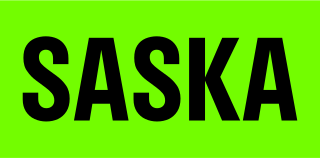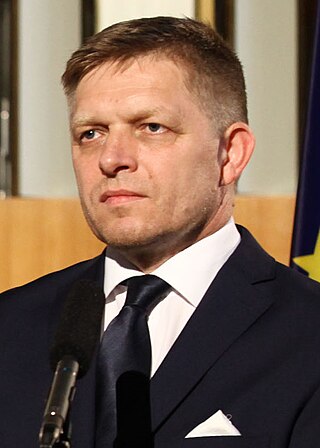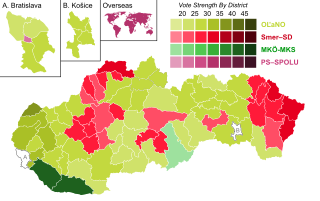Politics of Slovakia takes place in a framework of a parliamentary representative democratic republic, with a multi-party system. Legislative power is vested in the parliament and it can be exercised in some cases also by the government or directly by citizens.

Mikuláš Dzurinda is a Slovak politician who was the prime minister of Slovakia from 30 October 1998 to 4 July 2006. He is the founder and leader of the Slovak Democratic Coalition (SDK) and then the Slovak Democratic and Christian Union. From 2002 to 2006, his party formed a coalition government with the Christian Democratic Movement, the Alliance of the New Citizen and the Party of the Hungarian Coalition.

The Slovak Democratic and Christian Union – Democratic Party is a liberal-conservative, Christian-democratic political party in Slovakia. The SDKÚ-DS was a member of the Centrist Democrat International and was a member of the European People's Party until 2018, when it was expelled due to inactivity.

Direction – Social Democracy, also commonly referred to as Smer, is a left-wing nationalist political party in Slovakia led by the incumbent prime minister Robert Fico.

Monika Beňová is a Slovak politician who has been a member of the European Parliament since 2004. She is a member of the centre-left Direction-Social Democracy party SMER-SD. SMER-SD is a member of the Party of European Socialists. She presently serves on the Committee on the Environment, Public Health and Food Safety. At the same time she serves as a Quaestor of the European Parliament and therefore she is a member of the European Parliament's Bureau. In present she has opposite views as her mother party - Smer, for example on European Union, NATO, LGBTQ rights in Slovakia, conflict in Ukraine and so on.

The Nitra Region is one of the administrative regions of Slovakia. It was first established in 1923 and from 1996 exists in its present borders. It consists of seven districts and 354 municipalities, from which 16 have a town status. The economy of the region focuses more on agriculture, than in other Slovak regions. Nitra is its seat, largest city, and cultural and economic center.

The Bratislava Region is one of the administrative regions of Slovakia. Its capital is Bratislava. The region was first established in 1923 and its present borders exist from 1996. It is the smallest of the eight regions of Slovakia as well as the most urbanized, most developed and most productive by GDP per capita.

Robert Fico is a Slovak politician who has served as the Prime Minister of Slovakia since 2023, having served previously from 2006 to 2010 and from 2012 to 2018. He has founded and led the Direction – Social Democracy (Smer) party since 1999. First elected to Parliament in 1992, he was later appointed to the Council of Europe. Following his party's victory in the 2006 parliamentary election, he formed the first Fico Cabinet.

Daniel Lipšic is a Slovak politician and Jurist. He is a former Deputy Prime Minister, Minister of Justice and former Minister of Interior. Until 28 May 2012 he was a member of the Christian Democratic Movement (KDH), in which he served as vice-president and a Member of Parliament. Through his legal and political career, he is noted for his hard-line stance regarding officials from the former communist Czechoslovak regime, as well as crimes committed during this period. A public anti-corruption activist, he is outspoken against perceived corruption in the political or financial sphere.

Iveta Radičová is a Slovak politician who served as prime minister of Slovakia from 2010 to 2012. She was the first woman to hold the position. Radičová led a coalition government as a member of the SDKÚ-DS. As prime minister, she was responsible for managing the economy after the Great Recession, and she supported budget cuts to reduce the government deficit. For the final months of her tenure, she also served as Minister of Defence. Prior to her tenure as prime minister, she was a member of parliament, the Minister of Labor, Social Affairs, and Family, and an unsuccessful presidential candidate in the 2009 presidential election.

Freedom and Solidarity is a liberal political party in Slovakia. Established in 2009, SaS is led by its founder and economist Richard Sulík, who designed Slovakia's flat tax system. It generally holds libertarian or anti-statist positions. After the 2020 Slovak parliamentary election, the party lost several seats in the National Council but became part of the coalition government with Ordinary People and Independent Personalities, For the People and We Are Family.

Most–Híd 2023 is an inter-ethnic political party in Slovakia. Its programme calls for greater cooperation between the country's Hungarian minority and ethnic Slovak majority. It was one of four parties in the Fico III government coalition, but lost all its seats in the National Council in the 2020 Slovak parliamentary election.

Parliamentary elections were held in Slovakia on 10 March 2012 to elect the 150 members of the National Council. The elections followed the fall of Prime Minister Iveta Radičová's Slovak Democratic and Christian Union – Democratic Party-led coalition in October 2011 over a no confidence vote her government had lost because of its support for the European Financial Stability Fund. Amidst a major corruption scandal involving local center-right politicians, former Prime Minister Robert Fico's Direction – Social Democracy won an absolute majority of seats.

Presidential elections were held in Slovakia on 15 March 2014, with a second round on 29 March 2014.

Robert Fico's Second Cabinet is the former government of Slovakia, headed by prime minister Robert Fico. Appointed on 4 April 2012, it consists of 14 members, 11 from the Direction - Social Democracy party and three independents. It replaced Iveta Radicova's cabinet after gaining an absolute majority in the Slovak parliament following the 2012 Slovak parliamentary election.
The following lists events that happened during 2015 in Slovakia.

Parliamentary elections were held in Slovakia on 5 March 2016 to elect the 150 members of the National Council. The ruling left-wing populist Direction – Social Democracy (SMER–SD) party remained the strongest party, but lost its majority. The Slovak Democratic and Christian Union – Democratic Party (SDKÚ-DS), which led the government between 2000–06 and 2010–12, was defeated heavily, failing to cross the electoral threshold and losing its representation in the National Council. The centre-right Christian Democratic Movement (KDH) also failed to cross the threshold for the first time since 1990, whilst the far-right nationalist Kotleba – People's Party Our Slovakia (ĽSNS) entered parliament for the first time.

Parliamentary elections were held in Slovakia on 29 February 2020 to elect all 150 members of the National Council.

Early parliamentary elections were held in Slovakia on 30 September 2023 to elect members of the National Council. Regular elections were scheduled to be held in 2024. However, on 15 December 2022 the government lost a no-confidence vote. Subsequently, the National Council amended the Constitution so that an early election could be held on 30 September 2023. This was the first snap election in the country since 2012.

























